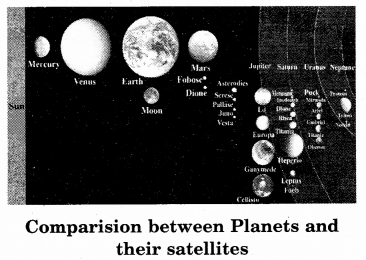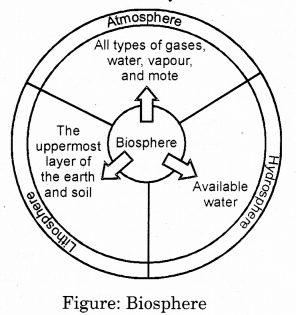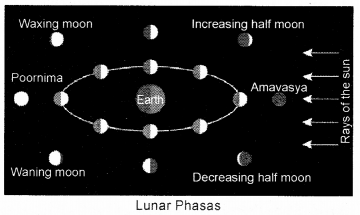RBSE Solutions for Class 6 Social Science Chapter 2 Solar System is part of RBSE Solutions for Class 6 Social Science. Here we have given Rajasthan Board RBSE Class 6 Social Science Chapter 2 Solar System.
| Board | RBSE |
| Textbook | SIERT, Rajasthan |
| Class | Class 6 |
| Subject | Social Science |
| Chapter | Chapter 2 |
| Chapter Name | Solar System |
| Number of Questions | 43 |
| Category | RBSE Solutions |
Rajasthan Board RBSE Class 6 Social Science Chapter 2 Solar System
Textbook Activity Based Questions and Answers
Question 1.
Why does possibility of life exist on Titan? (Page 12)
Answer:
Titan, the satellite of Saturn, has dense atmosphere like the earth. There are rivers, lakes, and the land found there is like that of the earth. The most important gas that is found in the atmosphere there is nitrogen. These conditions suggest presence of life there. The scientists are making efforts to find out whether there is possibility of life there or not.
Question 2.
From the table (Figure) of comparison between planets and satellites find out which planets have their own satellites and which do not have. (Page 13)

Answer:
The planets Earth, Mars, Jupiter, saturn, Uranus, Neptune have their own satellites. Mercury and Venus are such planets which are closest to the sun but they do not have their own satellites.
Question 3.
Prepare a table of planets and their satellites and find out which planets have satellites which are larger than moon. Titan, the satellite of Saturn, and Ganymede and Cellisto, the satellites of Jupiter are larger than the moon.
Answer:
| Names of Planets | Number of Satellites |
| Earth | 01 |
| Mars | 02 |
| Jupiter | 16 (approximate) |
| Saturn | 18 (approximate) |
| Uranus | 17 (approximate) |
| Neptune | 08 (approximate) |
Textbook Exercise
Question 1.
Choose the correct option
(i) At present, the number of planets is
(a) 8
(b) 9
(c) 10
(d) 12
Answer:
(a) 8
(ii) The biggest planet of the solar system is
(a) The Earth
(b) Mars
(c) Jupiter
(d) Saturn
Answer:
(c) Jupiter
Question 2.
Match the following
| 1. The largest planet | a. Venus |
| 2. Life planet | b. Moon |
| 3. Satellite of the earth | c. Earth |
| 4. The planet with rings | d. Jupiter |
| 5. The most shining planet | e. Saturn |
Answer:
1. d, 2. c, 3. b, 4. e, 5. a.
Question 3.
Fill in the blanks
1. The nearest heavenly body to earth is ……….. .
2. Our earth is …………. largest planet in the solar system.
3. The layer of gases around the earth is its …………… .
4. …………….. are celestial bodies which revolve around the planets.
Answer:
1. the sun
2. fifth
3. atmosphere
4. Satellites
Question 4.
Write the names of all the planets of the solar system.
Answer:
Sequence of planets on the basis of their distance from the sun is- Mercury, Venus, Earth, Mars, Jupiter, Saturn, Uranus and Neptune.
Question 5.
Between which two planets is our earth situated?
Answer:
The earth is situated between the planets Venus and Mars.
Question 6.
Why is life not found on the moon?
Answer:
It has been found by the discoveries made by modern astronomers that the air and water is absent on the moon, therefore life is not found on the moon.
Question 7.
What are the lunar phases?
Answer:
The moon is spherical in shape and it receives light from the sun. Therefore, the light of the sun falls on the half portion of the moon and its other half always remains in darkness. Once in a month, the moon’s fully illuminated face is visible in front of the earth. In India, it is known as Poornima. In the same way, once in a month, the dark portion of the moon is visible in front of the earth. This condition is known as Amavasiya. From the Poornima to Amavasiya, the illuminated part of the moon keeps on decreasing and from the Amavasiya to Poornima, this part keeps on increasing. These increasing and decreasing shapes of the moon are called the lunar phases.
Question 8.
In which two planets are asteroids found?
Answer:
Asteroids are found in the form of a belt between the planets Mars and Jupiter.
Question 9.
Why is the earth said to be an amazing planet?
Answer:
The uppermost layer of the earth is called lithosphere and soil is found there which provides food to all the living organisms. The gaseous layer around the earth is called the atmosphere. Hydrosphere is spread upon around 71 per cent part of the earth. In the entire solar system, lithosphere, hydrosphere and atmosphere are found only on the earth. The i iteraction of these three spheres gives rise to biosphere in which all flora and fauna exist. The information which is available to date in context to the universe suggests that the earth is the only planet where life exists. Therefore, it is known as an amazing and blue planet.
Other Important Questions
Objective Type Questions
Question 1.
According to modern astronomers, the age of the solar system is¬
(a) 420 crore years
(b) 460 crore years
(c) 480 crore years
(d) 500 crore years
Answer:
(b) 460 crore years
Question 2.
Which is an outer planet in the following?
(a) Mercury
(b) Earth
(c) Mars
(d) Jupiter
Answer:
(d) Jupiter
Question 3.
The planet nearest to the sun is
(a) Mercury
(b) Venus
(c) Earth
(d) Neptune
Answer:
(a) Mercury
Question 4.
The planet with the most number of satellites is
(a) Jupiter
(b) Saturn
(c) Uranus
(d) Neptune
Answer:
(b) Saturn
Question 5.
Which planet is known as the sister planet of the earth?
(a) Mars
(b) Mercury
(c) Venus
(d) Jupiter
Answer:
(c) Venus
Question 6.
Which of the following planets is called the ‘Blue Planet’?
(a) Mercury
(b) Venus
(c) Earth
(d) Saturn
Answer:
(a) Mercury
Match the following
| 1. Saturn | a. Pluto |
| 2. Jupiter | b. Earth |
| 3. Blue Planet | c. Titan |
| 4. Tiny Planet | d. Ganymede |
| 5. Dwarf Planet | e. Series |
Answer:
1. c, 2. d, 3. b, 4. e, 5. a.
Fill in the blanks
1. Celestial bodies revolve round the sun in a fixed elliptical path which is known as the ………….. .
2. International Celestial Council has granted Pluto the status of a …………… .
3. Venus is considered as the …………. of the earth.
4. The earth has only one satellite called the ………… .
5. The increasing and decreasing shapes of the moon are known as …………….. .
Answer:
1. orbit
2. dwarf planet
3. sister planet
4. moon
5. lunar phases
Very Short Answer Type Questions
Question 1.
In Indian culture, what is considered as ‘Grihapati’?
Answer:
In Indian culture, the sun is considered as ‘Grihapati’.
Question 2.
Who was the first to interpret about the central position of the sun and when did he/she do so?
Answer:
Nicolas Copernicus was the first to interpret about the central position of the sun in the year 1543 AD.
Question 3.
Write the names of those planets which do not have satellites of their own.
Answer:
Mercury and Venus are such planets which do not have satellites of their own.
Question 4.
Which planets are known as dwarf planets?
Answer:
Such celestial bodies which revolve round the sun in their fixed elliptical orbit and also cross the path of other bodies are known as dwarf planets.
Question 5.
What is the meaning of minor bodies?
Answer:
All tiny bodies revolving round the sun such as tiny planets, asteroids, meteors, etc., are collectively known as minor bodies.
Question 6.
Why is Venus called as the sister planet of earth?
Answer:
Venus is called as the sister planet of the earth because their shape and size is almost similar.
Question 7.
Why is life not possible on planets which are situated far away from the sun?
Answer:
The major reason for no possibility of life on planets which are situated far away from the sun is that they are excessively cold and their density is less.
Question 8.
How is lithosphere significant for mankind?
Answer:
Soil which is present on the lithosphere provides food to the living organisms on the earth and the minerals found on it are essential for the sustenance of the living beings.
Question 9.
What is meant by atmosphere?
Answer:
The gaseous cover found all round the earth is known as the atmosphere.
Question 10.
Which are the major gases present in the atmosphere?
Answer:
Major gases present in the atmosphere include – nitrogen, oxygen, carbon dioxide, and argon.
Question 11.
What are satellites?
Answer:
Satellites are small celestial bodies which revolve round the planets.
For example – Moon, Titan, Ganymede, Demos, Phobos, etc.
Question 12.
There is no possibility of life on the moon. Why?
Answer:
According to modem astronomers, there is no air and water on the moon. Therefore, there is no possibility of life on it.
Question 13.
What are tiny planets?
Answer:
There are very small planet-like bodies which revolve round the sun in the form of a belt present between the orbits of Mars and Jupiter. These bodies are known as tiny planets.
Short Answer Type Questions
Question 1.
What is meant by solar system?
Answer:
Planets, asteroids and comets collectively form a large celestial group which revolves round the sun. Group of all these celestial bodies along with the sun and the earth is known as the solar system.
Question 2.
What is meant by Shukla Paksh and Krishna Paksh?
Answer:
In India, the ascending lunar phases of days are known as Shukla Paksh (fort night) and the descending lunar phases of days are known as Krishna Paksh (fort night).
Question 3.
How have planets been classified?
Answer:
On the basis of their size, density and composition, planets have been classified into the following two types :
- Inner planets – Mercury, Venus, Earth and Mars are inner planets. They are small in size, have greater density and they have been built out of rocks.
- Outer planets – Jupiter, Saturn, Uranus and Neptune are outer planets. They are larger in size, have less density and have been built of gaseous or liquid substances.
Question 4.
Perform a comparative analysis of planets Earth and Jupiter.
Answer:
Following is a comparative analysis of planets Earth and Jupiter Basis of comparison Earth Jupiter
| Basis of comparison | Earth | Jupiter |
| 1. Revolution round the sun | Single revolution of the sun in 365 days. | Single revolution of the sun in 11 years 11 months. |
| 2. Rotation on its axis | It rotates on its axis in 01 day. | It rotates on its axis in 9 hours 56 minutes. |
| 3. Number of satellites | It has one satellite. | It has around 16 satellites. |
Long Answer Type Questions
Question 1.
What is meant by the term ‘Biosphere’? Explain with the help of a diagram.
Answer:
Biosphere is formed by the interaction of atmosphere, lithosphere and hydrosphere. That is, that part of all the three spheres present on the earth, where flora and fauna are found, is known as the biosphere. In this, all the gases, dust particles, vapour, upper portion of earth and various types of sea animals and creatures which live in water are included. Biosphere can be depicted in the following diagram

Question 2.
What are comets? Mention their characteristics.
Answer:
Comets are pieces of meteors or asteroids which get attracted towards the earth due to its gravitational force. Following are their characteristics :
- On their way to the earth, they get burnt due to friction with atmospheric particles.
- In the atmosphere, during friction, they appear as shining bodies with long tails which we call as falling stars.
- Some comets are so big that they do not diminish completely and they hit the earth’s surface. At this point, they are called as meteors.
- When they fall on the earth, they cause hollows on the earth’s surface.
Question 3.
What is moon? How many lunar phases are there?
Answer:
The moon is the closest spherical
inline
celestial body to the earth, which revolves round the earth. Due to this, it has been called the satellite of the earth. Its surface is rocky and uneven just like the earth’s surface. In comparison to earth, it is around 81 times smaller. It revolves on its axis in 29 days, and it revolves round the earth in 27 days. It shines due to the light obtained from the sun. Once in a month, its fully illuminated part comes in front of the earth.
In this part, we find its decreasing feature from Poornima to Amavasiya and increasing from Amavasiya to Poornima. These increasing feature and decreasing shapes of the moon are known as lunar phases and these are 16 in number. They have been depicted in the following diagram-

Question 4.
How many spheres are found on earth? Explain in brief.
Answer:
The following three major spheres are found on earth
1. Lithosphere, 2. Atmosphere, 3. Hydrosphere.
- Lithosphere : Lithosphere is the upper most layer of the earth in which mankind lives. Soils and various types of minerals found in the lithosphere are significant for sustenance of life of living organisms present on earth.
- Atmosphere : The gaseous cover which surrounds the earth is known as atmosphere. This retains around the earth due to the gravitational force of the earth. Gases have played a significant role in the composition of the atmosphere. Nitrogen and oxygen are the major gases present in the atmosphere. Apart from these, water vapour and dust particles are also present in it.
- Hydrosphere : It is spread upon around 71 per cent part of the earth’s surface. Water is found on earth in various oceans, seas, lakes and rivers.
Due to the interaction of all these three spheres, a fourth sphere named biosphere is formed. Living beings, flora and fauna and human beings exist reside in the biosphere itself.
We hope the RBSE Solutions for Class 6 Social Science Chapter 2 Solar System will help you. If you have any query regarding Rajasthan Board RBSE Class 6 Social Science Chapter 2 Solar System, drop a comment below and we will get back to you at the earliest.